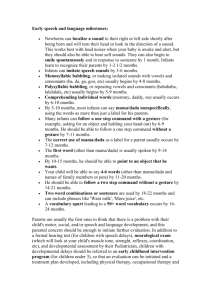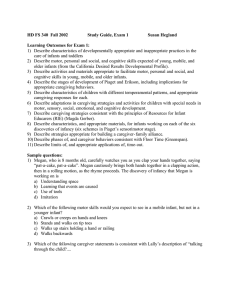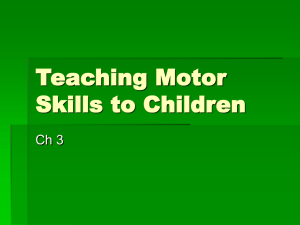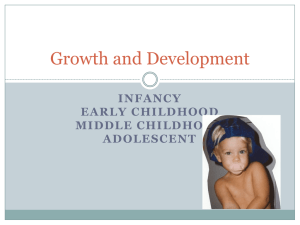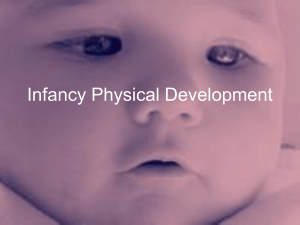Child Development: Principles & Theories - Chapter 4
advertisement
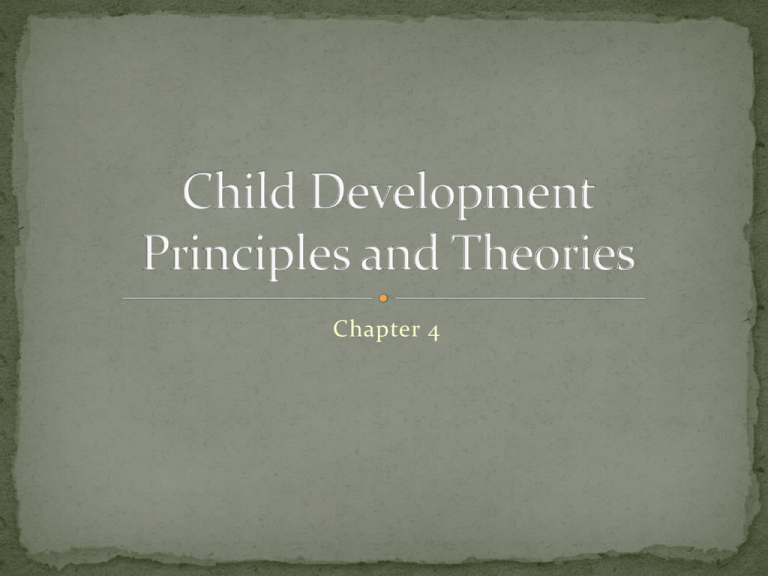
Chapter 4 Development Proximodistal principle Infant Maturation Toddler Neurons Preschooler Synapses Physical development Windows of opportunity Gross-motor development Theory Fine-motor development Schemata Cognitive development Sensorimotor stage Social-emotional Preoperational stage development Cephalocaudal principle Concrete operations stage Multiple intelligences Development – change or growth that occurs in children Infants – birth through the first year Toddlers – children from age one up to the third birthday Preschooler - children ages three to six Physical development Physical body changes that occurs in a relatively stable, predictable sequence These two are put together because learning to relate to others is social development. Emotional development involves feelings and expressing feelings. Trust, fear, confidence, pride, friendship and humor are all part of social – emotional development. Gross motor development – improvement of skills using the large muscles in the arms and legs. Includes activities such as running, skipping, jumping. Fine motor development – involves the small muscles of the hands and fingers. Includes grasping, cutting, holding. Cognitive development AKA intellectual development Processes people use to gain knowledge. Includes language, thought, reasoning and imagination Social – emotional development All three are linked to the other. Development in one area can greatly influence another. Example: Writing words requires fine motor skills (physical). It also involves language and thought (cognitive). Language is needed to communicate with others and is also necessary for growing socially and emotionally (social – emotional). Cephalocaudal principle Head downward Child first gains control of the head, then arms, then legs. Proximodistal principle Development proceeds from center of body outward Spinal cord develops before other parts of the body Arms develop before hands, hands and feet develop before toes and fingers Maturation Sequence of biological changes in children Depends on changes in the brain and nervous system These changes assist children to improve their thinking abilities and motor skills Specific spans of time for the normal development of certain types of skills Vision Birth to 6 months If a child is kept in a dark room for the first few months of life, vision will not develop properly Needs little stimulation to develop Infants need interesting objects to look at Emotional Control Birth to 3 years Includes the abilities to identify feelings, manage strong emotions and develop empathy. Severe stress or early abuse can damage a child’s emotional development Children need caregivers who can read their cues, respond promptly and meet their needs in a nurturing manner Vocabulary / Speech Birth to 3 years Infants must hear language to learn it Speak in full sentences Talk to children often Tell them what you are doing, what they are doing and what will happen next Read stories Play music Engage in social interactions that require language Math / Logical Development 1 to 4 years old Give children chance to work on materials that offer an appropriate level of challenge Motor Development Prenatal to 8 years Stable, long lasting structures can be created Young children need a variety of gross – and fine – motor activities to support motor development Feral children Erikson’s Psychosocial Theory Piaget’s Cognitive Development Theory Vygotsky’s Sociocultural Theory Gardner’s Multiple Intelligences Theory Stage 1: Trust vs. Mistrust Birth to 18 months To develop trust, infants need warm, consistent, predictable and attentive care When distressed, they need to be comforted Need loving, physical contact, nourishment, cleanliness and warmth They will devel0p a sense of confidence and trust that the world is safe and dependable Mistrust occurs if an infant experiences an unpredictable world and is handled harshly Stage 2: Autonomy vs. Shame and Doubt 18 months and 3 years Autonomy = Independence Objective is to gain self – control without losing self – esteem Children need to learn to choose and decide for themselves Children need positive opportunities for self-feeding, toileting, dressing and exploration Overprotection or lack of activities results in self- doubt, poor achievement and shame Stage 3: Initiative vs. Guilt 3 to 5 years of age Children need to develop a sense of purpose. This happens when an adult directs the child’s urges toward acceptable social practices. If children are discouraged by criticism, feelings of incompetence are likely to emerge. Stage 4: Industry vs. Inferiority 6 – 12 years old Planning and carrying out projects Helps children to learn society’s rules and expectations Realistic goals and expectations enrich children’s sense of self Children can develop a sense of incompetence and insecurity if they are discouraged, criticized or parents demand too much control Schemata – mental representations or concepts Assimilation – process of taking in new information and adding it to what the child already knows Accommodation – adjusting what is already known to fit the new information. Sensorimotor stage Birth to 2 years old Infants use all their senses to explore and learn Object permanence – children learn that objects still exist even if they are out of sight Preoperational stage 2 to 7 years old Children are egocentric Assume others see the world as they do Language, symbolic play and drawing is learned Conservation Even if the physical appearance changes, the amount does not change Classify groups of objects Concrete Operations stage Formal Operations stage 7 to 11 years old 11 years to adulthood Children develop the Think abstractly capacity to think systematically, but only when they can refer to actual objects and use hands-on activities Capable of reversing operations (1 + 3 = 3 + 1 ) Beginning to understand others’ POVs Problem solving Reasoning Vygotsky believed that children learn through social and cultural experiences While interacting with others, children learn customs, values, beliefs, and language of their culture Private speech Self – talk or “thinking out loud” Helps guide child activity and develop their thinking Zone of Proximal development Presents learning as a scale One end of the scale are tasks within child’s current development level. Other end of scale are tasks too difficult for children to accomplish, even with help Middle of scale are tasks children cannot accomplish alone When children receive help from a knowledgeable peer or adult it is called scaffolding. This person provides a structure for the child to learn, such as giving clues or demonstrating. Emphasizes that there are different kinds of intelligences used by the human brain. Believes intelligence is the result of complex interactions between children’s heredity and experiences. Each intelligence functions separately but are linked. Bodily – kinesthetic Ability to control one’s own body Use body to solve problems, handle objects and express emotions Children benefit from creative-moment experiences and role playing. Musical – rhythmic Recognizes musical patterns Appreciate and create music Background music helps stimulate thought Logical Ability to use reason and logic to solve problems Ability to explore categories, patterns and other relationships Benefit from using blocks and storybooks Verbal – linguistic Ability to use language for expression Children learn best by talking, listening, reading and writing Interpersonal Communication and social skills These skills are nurtured in your children when caring behaviors are modeled for them Intrapersonal Ability to understand the inner self Children can best learn this when sharing emotions that all children experience such as joy, sadness and disappointment. Use storybooks that contain emotional examples Visual – spatial Allows people to use their vision to develop mental images These children need unstructured materials such as building blocks and puzzles Also use visual aids, charts and labels Naturalistic Ability to classify objects in nature such as animals and plants To build on this, children need to be able to sort and classify items



